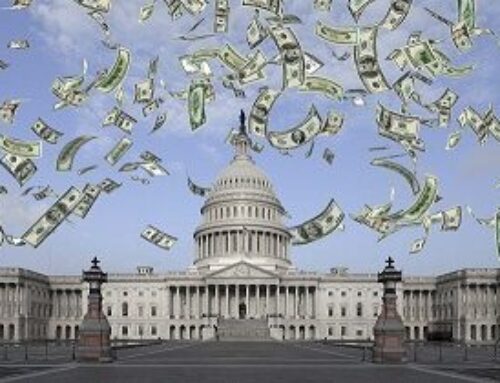TCS President Steve Ellis and Senior Policy Analyst Josh Sewell investigate a mystery that should strike fear into the hearts of all taxpayers, “Extra Money.” Plus, BWAF listeners will get an introduction to the not-so-distant relative of “Extra Money:” “More Credit.” Hit play and learn how American Taxpayers are confronted with the dual reality of needing urgently to increase the nation’s Debt Limit, even while we figure out how to use all that “extra money” laying around.
Listen here or scroll down to read a transcript
Episode 10 — Transcript
[INTRO]Steve Ellis:
Welcome to all American taxpayers seeking common sense, you’ve made it to the right place. For over 25 years, TCS, that’s Taxpayers for Common Sense, has served as an independent, non-partisan, budget watchdog based in Washington, DC. We believe in fiscal policy for America that is based on facts. We believe in transparency and accountability because no matter where you are on the political spectrum, no one wants to see their tax dollars wasted. And it is on that very sentiment that we will start the Budget Watchdog AF podcast today. Listeners, I hope you all had a great Independence Day holiday, I certainly did. Happy 245th birthday America. And yet I’m sad to report that my highly sensitive Budget Watchdog ears are ringing with the sound of a phrase that should strike fear into hearts of all taxpayers, extra money. What’s extra money you ask? Politicians of every stripe on both sides of the aisle are suddenly invoking this concept of extra money as a serious way to pay for new legislative priorities.
Steve Ellis:
Here to help us get to the bottom of this mystery of the extra money is TCS senior policy analyst, Josh, no pennies in his loafers, Sewell. Well, these days it may be no loafers at all. Josh, welcome back to the Budget Watchdog AF.
Josh Sewell:
Hey, thanks Steve. No shoes, no shirt, no problem in the podcast world.
Steve Ellis:
All right, let’s get into it. Josh, lawmakers at both ends of Pennsylvania Avenue are suddenly tucking their napkins into their shirts and getting ready to sop up all that extra money from COVID relief with a nice big crust of the new infrastructure loaf. Is this a taxpayer nightmare come true?
Josh Sewell:
Well first Steve, podcasts listeners may be wondering where Washington thinks this extra cash, this gravy, is coming from. It’s coming from you. This is your money. This is our money. This is taxpayer money. In responding to COVID-19, the federal government made some extraordinary changes. It was a crisis and so we opened the purse strings and we spent trillions of dollars, meted out through various programs. Some of them large pots of cash, some of them enormous pots of cash and we’re at this point now where hundreds of billions of it is left unspent. There’s leftover cash burning a hole in lawmakers’ pockets.
Steve Ellis:
What should be done to make sure that this money isn’t going to be wasted and spent responsibly?
Josh Sewell:
Well, there’s a number of principles lawmakers need to follow when responding to an actual crisis, five basic principles. Do what’s necessary, not what’s advantageous and that means you solve the crisis. You don’t solve every problem or treat it as a chance to grant legislative wishlists. Second, is deficits still matter in the long run. This is 100% borrowed money. There are no pay fors, we will have to pay it back someday. Third would be get the greatest positive effects. Frankly in an emergency, oftentimes cash is king. Food aid, rental assistance, this stuff goes out immediately. Time is of the essence so get it out the door. Fourth principle would be, emergency legislation should not make permanent changes or create longterm liabilities. Mid-crisis is not the time to re-engineer every program and your society. Finally, transparency and accountability are key. We have to follow the money and make sure it goes where needed and only where needed.
Steve Ellis:
We’ve often talked about how instead of throwing huge pots of cash at problems like disasters, the money then should be either meted out over time or have some triggers or other mechanisms to release the funds when or if necessary and even have some clawback type of actions but that’s not what’s happening here. How did we get in this spot, Josh?
Josh Sewell:
Well, I think a lot of it has to do with something that former congressmen and president Obama’s first chief of staff, Rahm Emanuel used to say, “You never let a crisis go to waste.”
Steve Ellis:
In other words, strike while the iron’s hot.
Josh Sewell:
Exactly. When you have a crisis like the pandemic and the big economic shock that comes from the response to it, lawmakers know that the purse strings are wide open and it’s time to roll out new programs. Now to an extent, that’s fine. Again, it’s an emergency. We need to respond and maybe the programs we have don’t respond the way they need to respond so we need to find some new ways to assist people. But when you just have a massive amount of money and you say, “Figure it out,” it doesn’t work always. We’re a year and a half into this pandemic and its response and so we know that some things work and some things didn’t. For example, the PPP program, the Paycheck Protection Program, that was one of these things that it started out, there was not enough money in it and they refilled it again.
Josh Sewell:
And they realized, oh, it’s not going to people we need it to go to, it’s going to massive corporations that weren’t supposed to be eligible so they came back and they changed it. And then money went out again so they send more money again. That’s the kind of thing that you need to look at. You need to say, “Here’s a little bit of funds. Let’s figure out what’s working, what didn’t work and we can fill in more money if we need to and if we can change the program as we move.” But what you come down to is that oftentimes there is more cash in the pot then is actually needed to stem the crisis and so some was left over and we’re seeing that’s the reality in many of the responses in other parts of the economy.
Steve Ellis:
Sure. I can recall that more than 10 years after Hurricane Katrina, there was still money that was allocated to that, that wasn’t spent. Just in the case with this pandemic and the economic crisis that accompanied it, as bad as it was and the job losses and the economic downturn, there were also new businesses created, people through the PPP still got paid and spent cash and so it didn’t use up all the money that was allocated to the pandemic response.
Josh Sewell:
You’re right. And to the tune of more than $100 billion, including unspent unemployment funds from states that ended the benefit early. And that’s just one pot of funds. In agriculture we saw at the beginning of this, there were projections that they were going to lose $50 billion in sales in 2020 and it didn’t happen. Obviously there were some farmers who lost some money, but there were other sectors that actually made more money than they had anticipated because they adapted to the new environment and they got some amount of assistance. But in reality, the losses weren’t there. Now USDA is flush with cash and is having to figure out where to spend that money.
Steve Ellis:
Yet again, Josh is able to work in ag policy into a podcast. It wouldn’t be a Budget Watchdog AF with Josh if we didn’t talk ag and USDA at some point. What do lawmakers want to do with that cash? And we kind of hinted to this or even said it a little bit beforehand, but just to remind folks.
Josh Sewell:
Unspent COVID funds is one of the supposed, so-called pay fors in the infrastructure package between President Biden and a handful of bipartisan senators and they claimed they will find $80 billion to invest in infrastructure by using those funds.
Steve Ellis:
But those funds are not a pay for, they’re not an offset. Money that isn’t spent for the purpose it was appropriated for should go back to the Treasury. It’s not their money. They can’t just spend it on their BIF, the so-called bipartisan infrastructure plan.
Josh Sewell:
Exactly. I 100% agree with you but it’s the way lawmakers look at this money is that once that money has gone out the door, there’s no way they’re ever going to pull it back. Even if the crisis is over or if the need is not there, this money is out there so they want to spend it on something. Now I’m a big fan of offsets and I think infrastructure needs offsets but not ones that paper over the deficit or are just completely fake. And this isn’t the only thing that’s a bad pay for. Things like selling oil from the Strategic Petroleum Reserve, macro economic effects from passing the bill. These are retreads we see in pretty much every big package and they’re very speculative. You’re making a lot of assumptions for future revenue when you have very real costs upfront and there’s always some voodoo in economics but we need to focus on facts and real figures.
Steve Ellis:
And we know that these fake offsets or retread offsets still add to the deficit and ultimately to the debt. Now, speaking of debt, dear listeners, let me introduce you to a not so distant relative of extra money, a warm Budget AF welcome please for, more credit. That’s right, we, the American taxpayers, are confronted with a dual reality of needing urgently to increase the nation’s debt limit even while we figure out how to use all that so-called extra money laying around. Josh, we have a complicated fiscal family tree here, don’t we? Can we make it work? Help all of us understand the details of how we got here and what comes next.
Josh Sewell:
The debt limit is a simple and complicated thing at the same time. Essentially, there is a limit to the amount of debt the government can accrue. There’s set by law, a cap. Once that cap is breached, the government could still spend money, but it cannot take on more debt. It can only spend what revenue comes in so you’re going hand to mouth. Been put into place because it’s an attempt to try to force itself to make decisions. Without ever having to make a choice, running up to a debt cap, then you would just see perpetual spending and perpetual deficits.
Josh Sewell:
And so over time, lawmakers have had to make decisions when coming near to the statutory debt limit, usually they just raise it. But oftentimes what has happened is it’s an opportunity in exchange for increasing the debt limit, the parties that are in power often extract some sort of concession and that is spending cuts or tax increases. Some way of getting the deficits, which add to the debt, getting the deficits in line in order to not have such a high debt. The last time Washington really addressed the debt ceiling was in the Bipartisan Budget Act of 2019. But instead of raising the debt ceiling, they merely suspended it.
Steve Ellis:
What do you mean suspend the debt ceiling? We don’t know what the total debt the country can run up is?
Josh Sewell:
Well, we will know on July 31st.
Steve Ellis:
Okay. Explain to podcast listeners how this works.
Josh Sewell:
In that 2019 budget deal, lawmakers and then President Trump agreed to suspend the debt ceiling until July 31st, 2021. Then whatever the debt is on that day, that’s the new debt ceiling.
Steve Ellis:
But then if the ceiling is set on July 31st, what happens on August 1st?
Josh Sewell:
Well, first of all, that’s so far away who cares. And that’s how Washington thinks, but the truth is as of now, extraordinary measures happen. And so that’s where the Secretary of the Treasury can take all kinds of creative accounting mechanisms to extend that time period between when they technically breach the debt ceiling and when you really do. There’s all kinds of things like not pay into the Civil Service Retirement Fund. All that cash that goes into federal workers’ pay and to their retirement, the Treasury holds it instead of actually investing it in the retirement. And there’s other little things where they can shift money around and basically not pay our bills. The check will be in the mail, it’ll just be in the mail later.
Steve Ellis:
I’ve heard that the Republican Study Committee, which is a large group of conservative House members has said they won’t approve a debt limit increase without spending cuts or budget caps. I know the answer, but Josh tell our listeners what the RSC said about raising the debt limit in the BBA, the Bipartisan Budget Act of 2019. Josh, Josh, are you still there?
Josh Sewell:
Sure Steve. You asked me what they said in 2019 so I said nothing, which is pretty much what they did.
Steve Ellis:
Clever.
Josh Sewell:
Yeah. It seems like certain things only matter when the guy from your party is in the White House and for Republicans, that’s often deficit and debt. At Taxpayers for Common Sense, we like budget caps and certainty but we can’t play a game of chicken when it comes to the debt ceiling. Part of the argument as to why the country should deficit finance infrastructure or say the American Family’s Plan is that it is cheaper to borrow. Why is it cheap to borrow? Because the world has faith that Uncle Sam will pay his debts.
Steve Ellis:
You’re talking about the full faith and credit of the United States.
Josh Sewell:
Absolutely. And historically, we’ve kept that. And as a nation, we benefit tremendously from our history of paying our bills on time. And we’ve benefit from being the reserve currency of choice. People out there want our debt because it is safe. We don’t default on our debts. Even when we play chicken, we have not defaulted, but if we default even not paying ourselves, that faith and that credit evaporates.
Steve Ellis:
You said, pay ourselves?
Josh Sewell:
When you look at the federal debt, the federal debt owed to the public stands at over $22 trillion right now, but there’s another about six trillion the government owes itself. And this is mainly because of trust funds. Take Social Security. For years, more is paid in taxes than is drawn in benefits. That excess, it doesn’t go in some lockbox, it’s spent. The government borrows that. It takes that cash and it spends it on other needs. And so the government is actually borrowing from the trust funds with a promise to pay it back when needed. I can’t tell you how many trust funds there are in the government because I don’t know. And honestly, the government doesn’t really have a good accounting of it. There are some very large ones like Social Security and Medicare, but there’s over a 100 for various items, but all that excess money that goes in those is borrowed later and that total borrowing within the government is at about $6 trillion.
Steve Ellis:
Wow. And we pay that back or supposedly paying that back with interest as well. And so, I think that getting into sort of the insolvency or potential insolvency of the big trust funds like Social Security and Medicare is a subject for another podcast but what’s really at hand here on July 31st is like you said, the lawmakers are playing chicken with the full faith and credit of the United States. This is going to have potentially costly consequences that I don’t think people really recognize the benefit of the dollar being the big dog. That transactions are conducted in dollars. The price of oil is set in dollars. We can’t afford to mess that up and defaulting on our debt will do just that. All right, we’ve laid out the concerns and the problems, how does Congress go about raising the debt limit, Josh?
Josh Sewell:
Well, there’s really two very simple ways of doing it. One, you can do it through reconciliation, when you have a budget resolution. The other is even simpler, you can just vote on it. All they have to do is vote to raise it. Now, voting may not be simple anymore, but that’s one of the easiest ways they can do it is to make the choice to raise the debt ceiling. But what they should do at the same time is make some of those tough choices to figure out how to reduce our deficits and get our spending more in line with our actual revenues.
Steve Ellis:
Some people have called in the past for eliminating a debt ceiling. It’s not something that we’ve always had as a country. I wish that lawmakers didn’t play partisan politics and chicken with it. I think it’s too important but it is an inflection point and it is an opportunity where we can reckon with the fact that we have a debt that is exceeding the size of our GDP, that we have real challenges and then try to tackle those. But instead when you kind of just run right up until the date, really there’s no option but to extend it and kick that can. Back in 2019, August 31st, 2021 seemed a long, long way away but it’s here. And heck, we spent trillions of dollars that we didn’t expect to in the interim. And you have this Jekyll and Hyde thing of where we’re talking about increasing the ability to borrow more while at the same time, lawmakers are saying that we have extra cash. How can we be nearly $30 trillion in debt and have extra cash? It’s just kind of mind boggling in that respect.
Steve Ellis:
There you have it, podcasts listeners, taxpayers are holding the bag and it really seems to be leaking. Feast and famine, extra money, it’s your money. Thanks for listening to Budget Watchdog AF. Subscribe and share. Taxpayers for Common Sense has your back America, we’re reading the bills, monitoring the earmarks and highlighting those wasteful programs that poorly spend our money and shift longterm risk to taxpayers.











Get Social